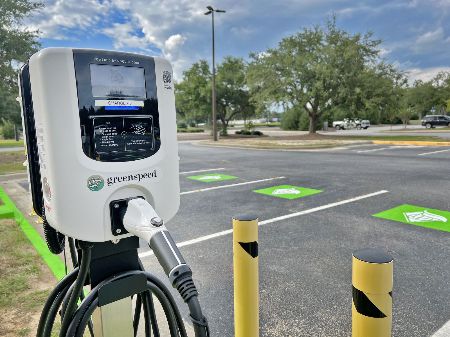How to Stay Updated on Industry Developments When You Buy EV Charging news
How to Stay Updated on Industry Developments When You Buy EV Charging news
Blog Article
Top EV Charging Information: Trick Updates on Infrastructure and Development

Recent Improvements in Fast-Charging Modern Technology

Furthermore, innovations in battery technology, consisting of boosted thermal administration systems and greater power density batteries, complement fast-charging capacities. These developments alleviate the threat of battery degradation throughout quick charging, ensuring durability and efficiency for EV proprietors.
Additionally, the combination of clever billing solutions is improving individual experience, making it possible for real-time monitoring and dynamic prices versions. EV Charging news. This adaptability allows chauffeurs to enhance billing times and prices based on grid demand
As automakers continue to buy fast-charging networks, the partnership in between sector stakeholders is crucial. Partnerships between charging station companies and vehicle producers are leading the way for substantial coverage, eventually cultivating a much more durable EV ecological community. These developments are essential in sustaining the shift to lasting transportation.
Federal Government Campaigns for Billing Growth
Federal government efforts play a vital function in the development of electrical car (EV) billing facilities, promoting the transition to lasting transport. Various federal and state programs are being executed to improve charging ease of access, minimize the economic burden on consumers, and advertise the adoption of electrical vehicles.
Notably, the united state federal government has actually allocated significant financing with the Infrastructure Financial Investment and Jobs Act, which earmarks $7.5 billion for EV billing network advancement across the country. This financing is targeted at releasing hundreds of new billing terminals, particularly in underserved locations, therefore dealing with variety anxiousness amongst potential EV customers.
In addition, countless states are passing regulations to simplify the allowing process for charging station setups, which is vital for accelerating deployment. Rewards such as tax credit reports and refunds for both customers and businesses are additionally being presented to urge the installation of charging facilities.
In addition, public-private partnerships are increasingly ending up being an emphasis, leveraging personal investment to complement government financing. These initiatives underscore a joint technique essential for constructing a detailed and reliable EV billing network, ultimately adding to a greener and more sustainable future.
Ingenious Battery Solutions Enhancing Performance
Changing the landscape of electric vehicle (EV) technology, cutting-edge battery remedies are considerably boosting effectiveness and efficiency. Advances in battery chemistry, particularly with lithium-sulfur and solid-state batteries, are resulting in boosted energy density, which enables longer arrays and faster charging times. These new battery kinds have the prospective to exceed traditional lithium-ion batteries by supplying greater abilities while minimizing weight, consequently improving total vehicle efficiency.
Furthermore, developments in battery monitoring systems (BMS) are optimizing power use and expanding battery life expectancy. Smart algorithms monitor battery wellness and performance, making it possible for real-time changes to charging and discharging processes. This not just enhances the performance of the battery however also makes sure a more dependable and sustainable power resource for EVs.
Additionally, the assimilation of recycling technologies is resolving the ecological influence of battery manufacturing and disposal. Innovations in second-life applications for EV batteries are promoting their use in energy storage systems, adding to a circular economic situation.
As these innovative battery services continue to progress, they assure to change the EV market, making electric cars more enticing and easily accessible to a wider audience while sustaining worldwide sustainability goals.

Partnership In Between Automakers and Charging Networks
Identifying the critical requirement for a durable charging facilities, car manufacturers are increasingly collaborating with charging network companies to improve the EV possession experience (EV Charging news). These partnerships intend to produce a seamless billing community that profits customers and supports the change to electrical automobiles
Significant automobile brands are joining pressures with well-known charging networks to expand their billing station coverage, ensuring vehicle click resources drivers have access to convenient and reputable charging choices. Partnerships with networks like ChargePoint and Electrify America enable car manufacturers to incorporate charging options directly into their vehicles' navigation systems, assisting individuals to the closest stations and offering real-time schedule updates.
In addition, these partnerships commonly lead to the development of fast-charging technologies that dramatically lower the time required to charge an EV. By pooling resources and experience, car manufacturers and charging networks can introduce quicker, developing services that meet the growing demand for electric wheelchair.
Furthermore, joint efforts might additionally bring about even more standard billing procedures, which can minimize customer complication and advertise wider EV adoption. Generally, these tactical partnerships are critical in building a effective and easy to use billing facilities that fulfills the needs of a broadening electric vehicle market.
Obstacles Encountering EV Billing Facilities
As the electric lorry market continues to expand, several challenges are appearing that prevent the development of a thorough charging facilities. Among the main challenges is the not enough number of charging stations, specifically in underserved and rural city areas. This space creates variety anxiousness amongst prospective EV purchasers, hindering them from making the button.
Additionally, the lack of standardization in charging technology complicates the framework landscape. Variations in plug kinds and charging rates can develop confusion for users and raise operational complexities for charging network drivers. The integration of billing terminals into existing electrical grids postures significant difficulties. Several regions deal with capacity constraints, requiring significant financial investments in grid upgrades to accommodate increased need.
One more pressing concern is the high price associated with the setup and maintenance of charging stations, which can be a barrier for both public entities and private companies. Finally, regulatory difficulties and zoning constraints can postpone the implementation of charging facilities, hampering development in broadening vital services. Addressing these challenges will be important for promoting a robust EV ecological community that supports the transition to lasting transportation.
Final Thought
To conclude, the recurring improvements in EV charging innovation, supported by significant federal government efforts and innovative battery remedies, are critical for the development and effectiveness of electrical vehicle facilities. Collaborations in between automakers and charging suppliers additionally improve terminal insurance navigate here coverage, addressing the expanding need for easily accessible billing options. Despite difficulties that persist within the EV charging landscape, these developments represent a favorable trajectory towards a more reliable and sustainable electric vehicle environment.
Advancements in charging facilities have led to the advancement of ultra-fast battery chargers qualified of delivering up to 350 kW of power, dramatically decreasing billing times. Variations in plug types and charging rates can produce confusion for users and boost functional intricacies for billing network drivers.In conclusion, the continuous improvements in EV charging technology, supported by visit this website considerable government initiatives and innovative battery solutions, are essential for the growth and performance of electric vehicle facilities. Partnerships in between car manufacturers and charging providers further boost terminal coverage, resolving the expanding demand for obtainable charging alternatives. In spite of obstacles that continue within the EV billing landscape, these advancements indicate a positive trajectory in the direction of a more effective and lasting electric automobile community.
Report this page